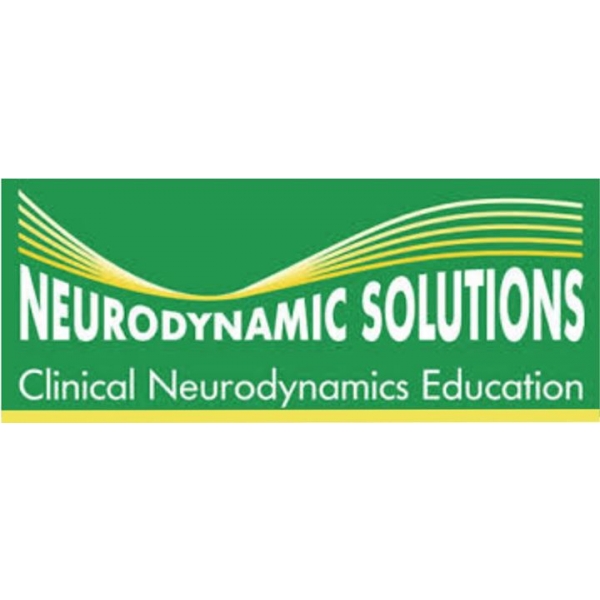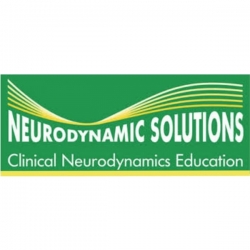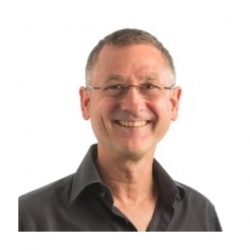Clinical Neurodynamics Education
臨床神經動力學 認證研習會 level 2
頸椎上肢、腰椎下肢 進階 (實體)
- 個案的神經電學檢查都正常,臨床上也沒有神經學缺損的表現,但疼痛、麻刺就是醫不好。
- 個案真的有神經壓迫問題,但病人可能因年紀大或有內科問題不願意開刀,但吃藥、注射效果不佳,不知道該怎麼辦。
- 個案原本有神經壓迫問題,但在壓迫解除後(開刀、注射、復健),仍然遺留疼痛、麻刺的後遺症,很難斷根。
- 搞不清楚個案的疼痛問題,到底是肌肉骨骼系統來的、還是神經系統來的?
- 醫師作完神經解套注射(hydrodissection)後,療效相當短暫,苦無補強方法?
世界知名的 "臨床神經動力學" 大師 Michael Shacklock 對於以上問題提供了完整的、系統化的解決方案。他於2005年完成了〝Clinical Neurodynamics : A New System of Neuromusculoskeletal Treatment〞一書,將“臨床神經動力學”的概念應用於臨床診療實務,解決了許多從前無法處理的臨床難題,堪稱神經動力學領域的鼻祖宗師。此書後來成為全球知名的暢銷教科書,他個人也享譽國際至今。
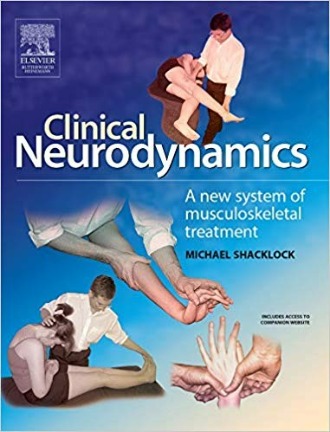
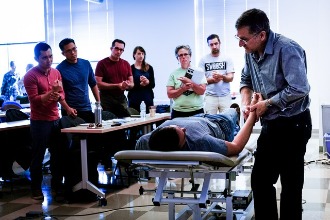
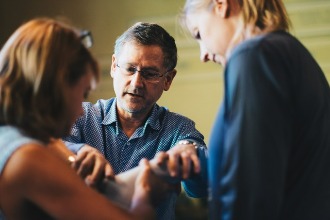
Shacklock大師除了忙於臨床工作外,也不斷受邀在世界各地演講教學,行程非常緊湊忙碌。我們非常難得地邀請他為台灣的學員講授 “臨床神經動力學” 講座,為國內醫療專家在處理相關臨床問題時,提供一個實用有效的臨床思路與系統化的診療工具。“臨床神經動力學”的科學理念和相關診療技術的應用,必能大大提升學員的臨床功力,是臨床執業工具箱中不能缺少的重要技能。
Level 1 講座的教學目標,是針對臨床上最常見的上肢與下肢神經問題,讓學員實際學會實用的神經動力學評估與治療。 講座的時間佔比: 實作65%,理論35%。充分的手法練習,讓學員能即學即用。
本課程由Shacklock大師實體教學。理論與實作兼具,讓您體驗正宗神經動力學的精髓。學員結訓後,授予NDS官方英文結訓證書。
講座介紹
上肢神經動力學進階講座將著重在臨床上較難界定的神經問題與肌骨系統相關的神經動態與動作療法的進階概念。
This course takes the upper quarter neurodynamics further into less recognized neural problems and more advanced concepts related to nerve movement and exercises in relation to the musculoskeletal system.
Objectives 學習目標
1.學習如何在神經動力學較複雜的區域中應用更進階的手法診斷與治療技巧。
Advanced manual diagnosis and treatment skills to new and more complex areas of neurodynamics
2. 學習如何診斷與治療更多的神經動力學功能障礙。
Learn diagnosis and treatment for more neurodynamics dysfunction.
3.增進臨床專家對於肌骨系統相關的神經動力學診斷與治療,包括多樣化的運動異常(dyskinesias)。
Expand the clinician’s skills in diagnosis and treatment of neurodynamics in relation to the musculoskeletal system, including various dyskinesias.
4.介紹有關神經動力學,最新的文獻回顧與臨床試驗。
Update the research literature (evidence) for neurodynamics, systematic biological, and physical mechanisms, reviews and clinical trials.
Course Highlights 學習重點
1.更多的臨床症候群介紹
More clinical syndromes
2.更多關於Shacklock臨床神經力學系統的診斷類別與更進階的臨床推理說明。
More diagnostic categories and advanced clinical reasoning illustrations of Shacklock’s Clinical Neurodynamics system.
3.以實際病人示範學習如何以神經動力學解決問題。
The patient demonstrates of neurodynamic problem-solving.
4.充沛而詳細的實作(hands-on) 與師生討論。
Detailed hands-on and discussional elements.
5. 學習更多神經動力學手法,並將它們應用在肌肉骨骼疾患。
Many new techniques for manual diagnosis and integration of the nervous with musculoskeletal practice.
What You Learn 學習大綱
1.學習如何診斷與治療複雜的動作功能障礙和神經動力學異常。
How to diagnose and treat more complex movement dysfunctions and neurodynamic disorders.
2. 頸因性頭痛和枕下肌肉群與硬腦膜連結部位之神經動力學處理模式
Neurodynamic aspect to cervicogenic headache and suboccipital myodural connections
肩胛上神經病變 Suprascapular neuropathy
腋神經 Axillary nerve
肘關節內側疼痛 (肘部正中神經和尺神經)Medial elbow pain (median and ulnar nerves at the elbow
橈神經 Radial sensory nerve
3. 更多多重結構問題的治療,包括:
Treatment of more multistructural problems including,
肩胛功能障礙,合併臂神經痛,臂叢神經和胸廓出口症候群的神經動力學
Scapular dyskinesia with neurodynamics for brachialgia, brachial plexus, and thoracic outlet syndrome
斜角肌,第一肋骨和臂神經叢的神經動力學
Scalenes, first rib, and brachial plexus
旋前圓肌症候群和肘隧道症候群的神經治療
Neural treatments for pronator and cubital tunnel syndrome
4.如何整合肩胛運動障礙與臂叢神經的神經動力學運動。
How to integrate neurodynamic exercises with scapular dyskinesia for the brachial plexus.
Lower Quarter level 2 Course (下肢進階部分)
下肢神經動力學進階講座著重在臨床上較難界定的神經問題與肌骨系統相關的神經動態與動作療法的進階概念。
This course takes the lower quarter neurodynamics further into less recognized neural problems and more advanced concepts related to nerve movement and exercises in relation to the musculoskeletal system.
Objectives 學習目標
1. 學習如何在神經動力學較複雜的區域中應用更進階的手法診斷與治療技巧。
Advanced manual diagnosis and treatment skills to new areas of neurodynamics
2. 學習如何診斷與治療更多的神經動力學功能障礙。
Learn diagnosis and treatment for more neurodynamics dysfunction.
3. 增進臨床專家對於肌骨系統相關的神經動力學診斷與治療。
Expand the clinician’s skills in diagnosis and treatment of neurodynamics in relation to the musculoskeletal system
4. 介紹有關神經動力學,最新的文獻回顧與臨床試驗。
Update the research literature (evidence) for neurodynamics, systematic biological, and physical mechanisms, reviews and clinical trials.
Course Highlights 學習重點
1. 更多的臨床症候群介紹- 膝蓋內側疼痛 (隱神經)。
More clinical syndromes- medial knee pain (saphenous nerve)
2. 更多關於Shacklock臨床神經力學系統的診斷類別與更進階的臨床推理說明。
More diagnostic categories and advanced clinical reasoning illustrations of Shacklock’s Clinical Neurodynamics system.
3. 以實際病人示範學習如何以神經動力學解決問題。
The patient demonstrates of neurodynamic problem solving.
4. 充沛而詳細的實作(hands-on) 與師生討論。
Detailed hands-on and discussional elements.
5. Many new techniques for manual diagnosis and integration of the nervous with musculoskeletal practice.
學習更多神經動力學手法,應用在肌肉骨骼疾患。
What You Learn 學習大綱
1.學習如何診斷與治療脊柱及下肢的動作功能障礙和神經動力學異常。
How to diagnose and treat more complex movement dysfunctions and neurodynamic disorders of the spine and lower limb.
2.與下背痛相關的神經動力學異常,包括小面關節和椎間盤症候群。
Neurodynamic relationships to combinations of low back pain, including facet and disc syndromes.
3.運動控制障礙和腿後肌損傷的坐骨神經問題的鑑別診斷。
Differential diagnosis for motor control problems and the sciatic nerve in hamstring injury
4.前髖、大腿和膝關節疼痛的股神經問題:
Femoral neural elements for anterior hip, thigh, and knee pain:
L2-4的神經根、股神經彎曲側試和俯臥時的膝蓋彎曲測試
L2-4 nerve roots, femoral slump test and prone knee bending test
股骨神經
Femoral nerve
隱神經與膝蓋內側疼痛
Saphenous nerve and medial knee pain
肌筋膜與神經元的結合
Combinations for neural and myofascial elements
5.腳痛 Foot pain
足踝關節疼痛與常見的腓神經及其遠端分支、表淺神經和踝關節扭傷的關係
Common fibular nerve and it’s distal branches, superficial nerve and sprained ankle and their relations to foot and ankle pain
腓腸神經與腓腸肌、阿基里氏腱和骰骨疾患的關係
Sural nerve and relation to disorders involving the gastrocnemius, Achilles tendon, and cuboid
脛神經和內側跟骨神經造成的足跟痛
Heel pain with tibial nerve and medial calcaneal nerve elements
莫頓氏神經瘤 (Morton’s Neuroma): 趾神經的介面與神經治療
Morton’s neuroma- interface and neural treatments for the digital nerves.
授課講師
MICHAEL SHACKLOCK
DipPhysio, MAppSc, FACP
NDS Instructor, founding director, principal
- Michael於1980年畢業於紐西蘭奧克蘭物理治療學院。
- 1985年,他前往澳大利亞的阿德萊德,在皇家阿德萊德醫院工作。他於1989年完成了高級手法治療研究生文憑課程,並於1993年在南澳大利亞大學取得碩士學位。
- Michael 於1995年在英國物理治療雜誌British journal of Physiotherapy上發表了著名的神經動力學的概念。
- Michael 於2005年由Elsevier, Oxford (2005)出版〝Clinical Neurodynamics : A New System of Neuromusculoskeletal Treatment〞一書,將“臨床神經動力學”這一概念引入臨床治療,此書也成了國際知名的暢銷教科書,Michael 因此國際知名至今。
- 除了"臨床神經動力學”以外,他還出版了另外兩本書:Moving in on Pain (Elsevier) 與 Biomechanics of the Nervous System: Breig Revisited(Breig Revisited)。同時他也在國際同儕評審的期刊共同撰寫和指導了許多研究論文、社論、評論和臨床論文,這些論文獲得了許多國際獎項,其中包括巴塞羅大學布宜諾賽勒斯醫學系客座教授。他也曾是英國肌肉骨骼理論與實踐(原手法治療)雜誌國際諮詢委員會的成員,也是美國手法治療雜誌的副主編。
- Michael在治療患者方面擁有41年的經驗,並被公認為神經肌肉骨骼疾病診斷和治療領域的國際領導者。

講座時間
日期:
2025年12月11-14日(共4天)
時間:09:00-17:00
講座議程
09:00-10:30 Session 1
Review and update:
- General neurodynamics
- Neuromyofasical dynamics, the difference between bone interface and myofascial structures in sliding techniques
- Importance of stabilizing the local structures when producing sliders
- Neurodynamic comerstones
- New research, validity, efficacy studies
- Specific neurodynamics
- New research on contralateral and bilateral neurodynamics
10.30-10.50 Morning tea
10.50-12.30
New neurodynamic tests;
- Contralateral and bilateral neurodynamic tests- 30 mins
- Bilateral MNT1
- Bilateral SLR for neck pain
Suprascapular, axillary and radial sensory nerves and neurodynamic tests- 30mins
Clinical features:
- Palpation
- Neurodynamic testing
- Treatment
12.30-13.30 Lunch
13.30-15.00
Advanced in Neuropathodynamics- lecture 30 mins
Physical examination
Theory- 15 mins new dysfunctions, interface and nerve, cervical spine and thoracic outlet practical, examine each other- 40 mins and make diagnostic hypotheses
15.00-15.20 Afternoon tea
15.20-17.00
Cervicobrachialgia
- Manual techniques
- Integration of muscle and interface dysfunctions
- Upper trapezius, levator scapulae, scalene and nerve
- Opening and nerve, closing and nerve
9.00-10.30
Cervicogenic headache neuromyofascial aspect:
- Theory, specific anatomy and neurodynamics- 30 mins
Physical examination and treatment -60 mins
- Palpation occipital nerves
- Neurodynamic testing
- Treatment of neurodynamics- progressions from level 1-3
10.30-10.50 Morning tea
10.50-12.30
Cervicogenic headache continued
Neurodynamics exercises
- Principles
- Techniques selection/ progressions system
- New models of neurodynamics, models A and B. Different relationships with the mechanical interface and diagnosis and mechanical treatment.
12.30-13.30 Lunch
13.30-15.00
Treatment of:
- Medial elbow pain from the median nerve (pronator tunnel syndrome)
- Ulnar nerve for cubital tunnel syndrome
- Thumb pain related to the appearance of de Quervain’s disease
15.00-15.20 Afternoon tea
15.20-17.00
Clinical reasoning and Neurodynamics:
- Reasoning model applied to diagnosis and treatment
- Case examples and problem-solving
- Level of the patient, diagnostic categories, and their presentations
- Treatment technique selection and progression.
9.00-10.30
Review and update neurodynamics to more advanced concepts:
- General neurodynamics
- Neuromyofasical dynamics, difference between bone interface and myofascial structures in sliding techniques
- Importance of stabilizing the local structures when producing sliders
- Neurodynamic comerstones
- New research
- Specific neurodynamics
- New research on contralateral and bilateral neurodynamics
10.30-10.50 Morning tea
10.50-12.30
Nerve Palpation:
- Femoral
- Lateral femoral cutaneous
- Saphenous
- Genicular Branches
- Digital nerves for Morton’s neuroma
Specific neurodynamic tests
- Contralateral and bilateral neurodynamic tests
- Slump
- Prone knee bend, detection of neurodynamic aspect
- Combinations of Neurodynamics and musculoskeletal structures: facet, myofascial
- Thoracic Spine, rib, and neural techniques for thoracic influence on lower limb pain.
12.30-13.30 Lunch
13.30-15.00
Advanced in Neuropathodynamics- lecture 30 mins
Physical examination for combination dysfunctions
Theory- new dysfunctions, interface and nerve, lumbar spine
Practical, examine each other and make diagnostic hypotheses
15.00-15.20 Afternoon tea
15.20-17.00
Lumbar diagnostic categories
- Manual techniques- integration of muscle and interface dysfunctions
- Nerve root sliding and opening and closing combinations
- Practical session performing treatments for the dysfunctions
9.00-10.30
Diagnosis of neural aspect to hamstring injury and disorders
- Contralateral mechanism
- Cause of hamstring tightness and its treatment
- Theory, specific anatomy and neurodynamics
Physical examination and treatment
- Palpation occipital nerves
- Neurodynamic testing
- Treatment of neurodynamics – progressions from level 1-3
10.30-10.50 Morning tea
10.50-12.30
Neurodynamics clinical reasoning model;
- Mechanisms categories
- Prioritization
- Neurodynamic clinical patterns and their recognition
- Practical application to
Fibular nerve influences on lateral knee pain
Gastrocnemius and tibial nerve
Sural nerve and Achilles tendon
12.30-13:30 Lunch
13.30-15.00
Clinical reasoning and Neurodynamics
- Reasoning model applied to diagnosis and treatment
- Case examples and problem-solving
- Level of the patient, diagnostic categories, and their presentations
- Treatment technique selection and progression
15.00-15.20 Afternoon tea
15.20-17.00
Clinical reasoning model application:
- Clinical cases and decision making
- Patient demonstration of clinical reasoning principles
17:00 Class dismiss
講座地點
全衡學苑:台北市中正區衡陽路20號6樓
【大眾交通】
捷運西門站四號出口步行約7分鐘。
捷運台大醫院站一號出口步行約5分鐘。
【停車資訊】
台灣聯通衡陽停車場: 臺北市中正區衡陽路51號B3-B6
請點我
主辦單位
中華全衡學會
合辦單位
澳洲 Neurodynamic Solutions 總部
報名資格
醫師、治療師
報名費用 報名費用
NTD $40,000 元 <不含餐點> 早鳥優惠: $38,000 元/人 (2025/07/31前報名繳費)
請記得於 <一週內> 繳費,才算完成報名手續喔!
**注意超過繳款期限,需重新報名。
**臨櫃匯款時,須於匯款單備註報名者姓名,以便核對匯款資料,謝謝。**報名繳費成功者,即自然成為本會本年度贊助會員。
報名連結 請點我
港澳學員請E-mail : tas.infocenter@gmail.com 來信詢問。
退費約定
- 若招生不足,本單位有取消講座的權利。
- 若因講座取消或改期而導致相關損失(如訂房費,交通費等),恕難由主辦單位負責。若因不可抗拒之因素而無法舉辦,則該講座之報名費全額退費。
- 若因個人因素無法參加,於「講座開始日」前31日之前申請退費者,酌收行政作業費用 $1000 元/堂(海外學員另有退費行政費用規範)。
- 「講座開始日」前30日至前16日間申請退費者,退還70%。
- 「講座開始日」前15日至前8日間申請退費者,退還50%。
- 「講座開始日」前7日及7日內申請退費或講座當天缺席未到者,恕不退費,日後亦無法補參加講座。
- 申請退費者,請以E-mail 通知本會。
轉課約定
- 轉課以一次為限,辦理後不得再次申請轉課。
- 講座開始日前 31日(含) 申請轉課者,如有產生退費差額,將酌收行政作業費用 $500 元/堂(海外學員另有退費行政費用規範)。
- 講座開始日前 30日內,不接受轉課申請,僅可依照退費約定辦理退費。
注意事項
- 由於日後無法補參加講座,請於報名前慎重考慮是否能出席講座。
- 講座時請穿著輕便寬鬆衣著,以便練習。
- 為尊重講師智慧財產,講座中除非講師許可,否則禁止錄影、拍照。
- 研習會以英文進行。講座中提供全程中文口譯。
- 本學會將於實體講座中進行拍照/錄影,您開始參與講座,代表您(學員)同意本學會收錄學員之肖像及聲音,並同意本學會基於課程與教材推廣之目的使用。
聯絡人
宋秘書 ( Tel: 02-2771-3221 )
全衡學苑LINE官方 ( ID: @408pmkfw )


